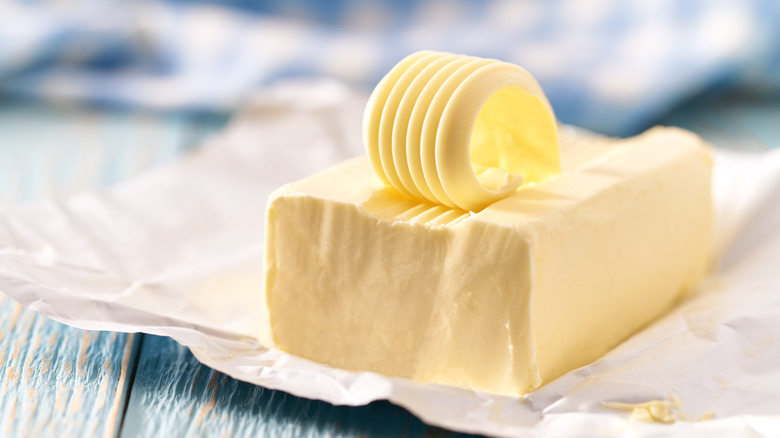The Science Behind How Cream Actually Becomes Butter
Unless you grew up off the grid or on a dairy farm (or both), you've probably always bought butter at the grocery store. Sticks of store-bought butter are convenient, perfectly measured, and last a long time in the fridge. But you might be surprised to know that it's actually really easy to make your own homemade butter with heavy cream. That's because the science of making butter is simple — it's just a matter of getting all the fat that's suspended in the cream to stick together and separate from the buttermilk.
Homemade bread exploded in popularity during the pandemic, so it stands to reason that interest in homemade butter tagged along for the ride. After all, nothing beats a slice of fresh bread with a smear of fresh, homemade butter on top. You don't need to be a scientist to make your own butter, but it helps to know how it works to get the job done right. To get your butterfat to do its thing, all you have to do is mix your cream either with a whisk or mixer, shake it in a jar, or even smash it in a homemade butter churn.
Smashing the cream's fat together yields butter
You might have never noticed the word "homogenized" printed on a container of milk or cream, or if you did, maybe you didn't think much about it. But in the case of dairy, this means that the naturally occurring fat in the cream is broken down into tiny little particles that are emulsified, or suspended, in the liquid of the milk. It's just like when you shake the oil into a vinaigrette, but with much tinier particles of fat. When you make butter, all you're doing is extracting the fat out of the cream. Fat molecules like to stick together if given the chance — you just have to give them a little coaxing with some manual mixing.
If you've ever accidentally left whipped cream in the mixer too long until it breaks, you're not just ruining your whipped cream — you're actually making butter. When you whip or churn heavy cream, the fats smash into each other and stick together. The longer you whip, the bigger the fat particles get, like when you roll a big snowball on the ground to make a snowman. Eventually, all the fat sticks together and the liquid, which is the buttermilk, gets separated out.
How to make butter from cream
Back in the old days, before electric stand mixers, people had to make butter with butter churns, which came in numerous shapes and designs. Many people opted for simple barrels with a large pole handle in the center. The person making butter would fill the barrel with cream and then push and pull the handle up and down, smashing the butterfat molecules together. Thankfully, in our modern times, you can just let an electric mixer do the job. Simply fill the bowl of a stand mixer about a third of the way full, which leaves space for the cream to expand as it's whipped. Start the mixer at the lowest speed and slowly bring it up to medium speed. After a few minutes, when the cream has thickened, raise the mixing speed to high and let it work for another five to 10 minutes. You'll notice large fat globules forming and separating from the buttermilk liquid, and you can cover the bowl with a cloth if the liquid starts to splash. Make sure to check on the butter's process, as some types of cream will thicken much more quickly than others.
Once your butter is completely separated from the buttermilk, you can drain off the buttermilk and save it for something else, like buttermilk biscuits, which would taste amazing with fresh butter. At this point, you can add any type of flavoring to the butter you'd like, and then scrape it all together. Some butter makers like to rinse the butter with cold water at this point to remove any lingering buttermilk, which will give it a longer shelf life. But if you plan to eat your butter within a few days, simply cover it in a container and spread it at will.


